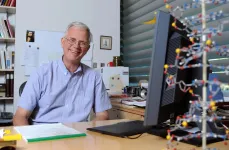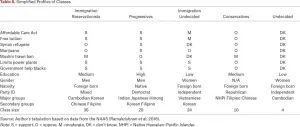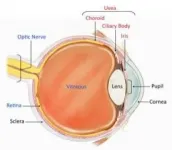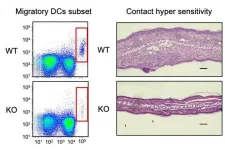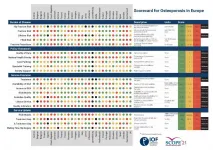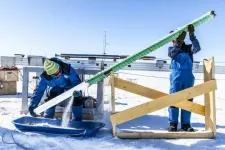(Press-News.org) While DNA provides the genetic recipe book for biological form and function, it is the job of the body's proteins to carry out the complex commands dictated by DNA's genetic code.
Stuart Lindsay, a researcher at the Biodesign Institute at ASU, has been at the forefront of efforts to improve rapid DNA sequencing and has more recently applied his talents to explore the much thornier problem of sequencing protein molecules, one molecule at a time.
In a new overview article, Lindsay's efforts are described along with those of international colleagues, who are applying a variety of innovative strategies for protein sequencing at the single-cell, and even single-molecule level.
"One of the surprises of the Human Genome project was that humans can be built from a mere 25,000 genes. The real complexity turns out to lie in the almost infinite number of ways proteins can be put together from this limited set of genes, and in the ways individual amino acids (the building blocks of proteins) can be chemically modified. For these reasons we need tools to analyze proteins at the single-molecule level."
Lindsay is the director of Biodesign's Center for Single-Molecule Biophysics, the Edward and Nadine Carson Presidential Chair in Physics at ASU and Regents Professor in the College of Liberal Arts and Sciences, Chemistry and Biochemistry.
The review was jointly supervised by Javier Alfaro, University of Gda?sk, Poland; Amit Meller, Technion-Israel Institute of Technology, Haifa, Israel; Chirlmin Joo, Delft University of Technology, the Netherlands; and Adam Pomorski, University of Wroclaw.
The research appears in the current issue of the journal Nature Methods.
Although cells may superficially appear identical, they are in reality unique entities with individual properties that may differ dramatically, with important implications for health and disease. Since proteins do most of the work within the cell, investigating cell-to-cell variation in organs, tissues and cell cultures can provide critical insights, particularly for the study of cancer, where individual cell mutations can become amplified, driving the progress of the disease.
The field of protein research, (known as proteomics) has traditionally been dominated by mass-spectrometry technologies, which are expensive and generally only sequence batch proteins contained in complex mixtures. Ferreting out single proteins in individual cells will require a transformation in sequencing technology similar to the DNA sequencing revolution. According to Alfaro, "the problem is that unlike DNA, there is no way to amplify proteins and this poses a big challenge to the sensitivity of current instrumentation."
Lindsay's approach to the problem involves a technique known as recognition tunnelling, which relies on a technology known as scanning tunnelling microscopy (STM). In earlier research, Lindsay applied STM to identify DNA bases sequentially fed through a tiny aperture known as a nanopore, much as one might feed thread through the eye of a needle.
As DNA nucleotides transit through the nanopore, they are momentarily held captive between a pair of electrodes. Current passing through each base, known as tunnelling current, produces tell-tale electrical spikes, which are like a fingerprint of each of the 4 bases, adenine, thymine cytosine and guanine.
Recent advances have allowed the same basic idea to be applied to the identification of proteins, through sequential identification of the 20 amino acids from which all proteins are built. While recognition tunneling of proteins follows the same basic game plan used to sequence DNA bases, the task is far more delicate for protein sequencing, requiring the bonding of amino acids to specialized adapter molecules for the tunneling current to pass through as well as machine learning algorithms to help pick out the precise amino acid being sequenced.
"This review is part of the launch of a world-wide effort to make single-molecule protein sequencing a reality, with many labs around the world contributing to a variety of new technologies, our electronic approach being one," Lindsay says.
"We expect that these ground-breaking technologies will penetrate into the market, particularly in pharmaceutical industry, academic research, and clinical diagnostics," said Chirlmin. "Using these technologies, we will be able to uncover the diversity of the proteome, study how the proteins communicate and interact, and provide new insights into how life actually works at the molecular level."
Continued advancement in protein sequencing may open the door to routine clinical application for diagnostic and treatment purposes, fulfilling the longstanding ambition of personalized medicine.
INFORMATION:
The recent attacks against Asian Americans have put Asians in the U.S. in the spotlight. Many of the victims are first-generation immigrants in ethnic communities, while those rallying for the victims are second-generation Asian Americans. A new Dartmouth study explores who Asian Americans are today and the range of identities this category encompasses.
The study, by END ...
An international coalition of eye researchers used machine learning to develop classification criteria for 25 of the most common types of uveitis, a collection of over 30 diseases characterized by inflammation inside the eye. Together, these diseases are the fifth leading cause of blindness in the United States. The Standardization of Uveitis Nomenclature (SUN) Working Group, funded by the National Eye Institute (NEI), published its classification criteria in the American Journal of Ophthalmology. NEI is part of the National Institutes of Health.
"In the past, clinical research in the field of uveitis has been hampered by the lack of widely-accepted ...
Lead is a toxic metal, and its widespread use has led to significant environmental pollution and public health problems in many parts of the world. This has led the WHO to include it on a list of ten chemicals that cause serious health problems. However, lead poisoning continues to affect many population groups. A study published today in open access in the journal Environment International found high levels of lead in indigenous people in Peruvian Amazonia living near areas where oil extraction takes place. The research was led by Cristina O'Callaghan-Gordo, a professor and researcher in Health Sciences Studies at the Universitat Oberta de Catalunya (UOC) and the Barcelona ...
As Australia officially enters winter, UniSA ecologists are urging coastal communities to embrace all that the season brings, including the sometimes-unwelcome deposits of brown seaweed that can accumulate on the southern shores.
While tidal seaweed (or sea wrack) may seem unsightly - especially at beach-side tourist destinations - new research from the University of South Australia shows that it plays a vital role for many migratory seabirds and should be protected.
In the first study of its kind, UniSA researchers show that beach-cast seaweed provides shelter, ...
Osaka, Japan - In a new study, researchers from Osaka University discovered a novel molecular mechanism by which immune cells migrate to fight off infections. These findings may help in understanding the development of certain immune deficiency disorders and establish novel therapies against them.
Immune cells represent a diverse group of cells. Some circulate in the blood stream and migrate to infected tissues after receiving signals from damaged tissues. Others reside in tissues to take up the invading microbe, migrate to lymph nodes and activate an immune response. Therefore, to function effectively, the immune system's activities ...
June 7, 2021 - Nyon, Switzerland -- A new report by the International Osteoporosis Foundation (IOF) draws attention to the burden of osteoporosis and the gaps and inequalities in the provision of primary and secondary prevention of fractures due to osteoporosis across Europe. 'SCOPE 2021: a new scorecard for osteoporosis in Europe' provides detailed findings for the 27 countries of the European Union as well as Switzerland and the United Kingdom (referred to as 'EU27+2'), covering key indicators for four domains: burden of disease, policy framework, service provision and service uptake.
Professor John A. Kanis, IOF Honorary President and lead author of SCOPE, stated:
"Osteoporosis is a major concern in Europe as it results in 4.3 million fragility fractures and health ...
Scientists have established the most reliable estimates to date of past temperature variations in Antarctica.
They highlight significant differences in behaviour between West and East Antarctica.
This study makes it possible to test and consolidate future climate projections.
Antarctica has experienced significant temperature changes, especially since the last glacial period. An international collaboration including scientists from the CNRS1 has now challenged previously accepted estimates of these variations, using new measurements published on June 4, 2021 in Science. Their study highlights differences in behaviour between East and West Antarctica, connected in particular ...
New research identified a novel interaction between the SARS-CoV-2 spike protein and the galectin-3-binding protein (LGALS3BP) which could be a new therapeutic anti-viral target. The research also found the presence of detectable viral RNA in blood in COVID-19 patients is a strong predictor of mortality.
The paper, published today in Nature Communications, was led by a group of researchers from King's College London, Guy's and St Thomas' NHS Foundation Trust and King's British Heart Foundation Centre. The research was funded by the NIHR Guy's and St Thomas' Biomedical Research Centre and supported by grants from BHF.
In the study, authors analysed close to 500 blood samples from patients ...
Cows can pass on the hypoglycin A toxin through their milk, a study by the Martin Luther University Halle-Wittenberg (MLU) and the Leibniz Institute of Plant Biochemistry (IPB) in Toxins shows. The substance can cause severe symptoms in humans and animals. Small amounts of the toxin were detected in the raw milk of cows that grazed in a pasture exposed to sycamore maple. The team calls for further investigations to realistically assess the potential dangers.
High concentrations of hypoglycin A can be found in unripe akee and lychee fruit and in the seeds and seedlings of various maple trees. These include, for example, the sycamore maple, which is common throughout Europe. The toxin can cause severe illness in humans. In 2017, a team of researchers in India ...
Travellers abroad may pick up bacteria and other vectors containing genes conferring antimicrobial resistance which remain in the gut when returning to their home country, according to a study published in Genome Medicine.
A team of researchers at Washington University, USA and Maastricht University, Netherlands investigated the presence of antimicrobial resistance (AMR) genes in the human gut microbiome by analysing the faecal samples of 190 Dutch travellers before and after travel to destinations in Northern Africa, Eastern Africa, Southern Asia ...
